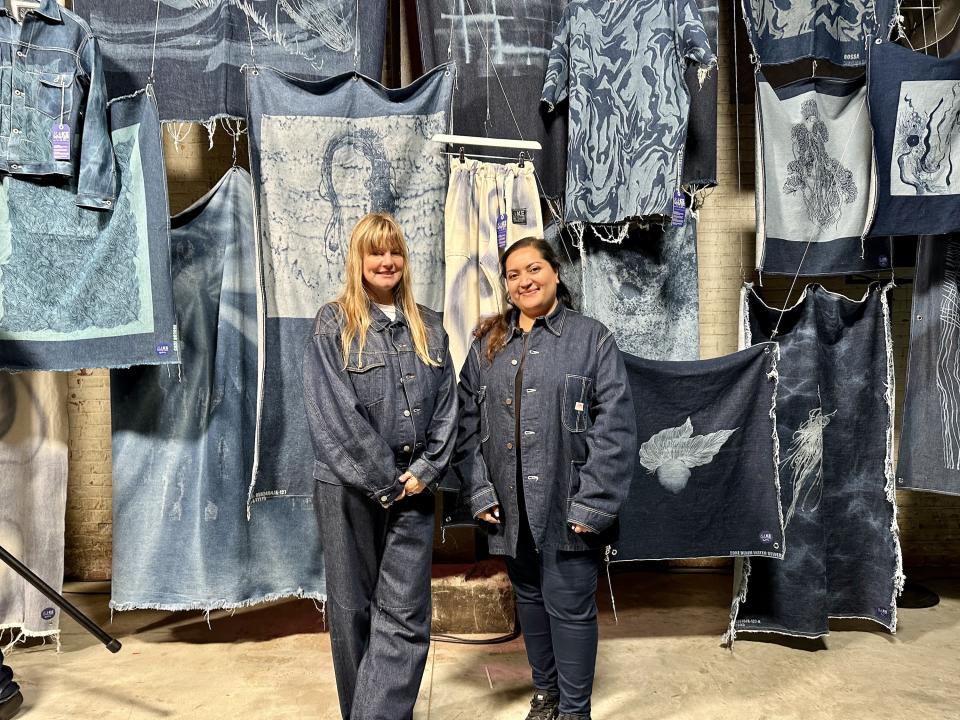Denim Supply Chain Offers Brands New Smart Chemistry and Finishing Solutions

Smart chemistry and efficient technologies are guiding the denim industry in a more responsible direction.
At Kingpins Amsterdam last week, companies shared the steps they’re taking to eliminate harmful chemicals from the supply chain, minimize the number of steps needed to produce a pair of jeans and the framework they’re following to meet the complex qualifications of standards and certifications.
More from Sourcing Journal
Zalando Launches ZIGN Studio Collection as Incubator for New Materials
Artistic Milliners Backs Carbon-Negative Black Pigment Dye Made from Wood Waste
For Bluesign, the event was an opportunity to discuss how mills, manufacturers and laundries can become a system partner through Bluesign Denim, an action plan that ensures jeans are safe for workers, the environment and consumers and are traceable across all aspects of production—chemistry, fabric and laundry.
The goal is for brands to be able to offer consumers Bluesign-approved jeans like Madewell, which became the first U.S. denim brand recognized by the sustainability authority as a system partner in August. The brand is expanding its uses Bluesign-approved fabrics from Turkish mill Isko.
Along with being sustainable and traceable, Bluesign CEO Daniel Rüfenacht said being a system partner increases a company’s efficiency. There are no unwanted RSL testing results because a Bluesign seal means “whatever leaves the factory is safe.”
Chemical and finishing technology companies continue to build on the innovations they debuted at the April edition of Kingpins Amsterdam and at ITMA in June.
With Atmos, Jeanologia showcased the possibilities of dry finishing for denim and knitwear. The Spanish company said the process “acts like a time machine” by using ozone under atmospheric conditions to achieve genuine vintage effects on garments without the use of water, pumice stones or chemicals.
Tonello highlighted the possibilities of DyeMate, a patent-pending technology that mimics the traditional indigo garment dyeing process, making it automatic and repeatable in an efficient and sustainable process. DyeMate was presented alongside the Italian company’s ozone, OBleach and EGO technologies.
Tonello’s technologies were the secret sauce behind several collaborations and concept collections at the show. Tonello processed the garments in One Denim, an initiative that aims to fight industry waste by showing the variety of looks that can be achieved with a single fabric through the latest finishing technologies. The collection showed garments made by Sharabati Denim and designed by industry veteran Piero Turk.
Tonello’s ozone and laser technologies were used by trend forecaster and designer Kelly Harrington and Sadia Rafique and Mohsin Sajid of Endrime, in their collection blurring art, technology and fashion.
Called SA-KE—a combination of Harrington and Rafique’s first names, which means “the purpose for doing something”—the collection spans 70 fabrics that Sajid handpicked from Artistic Fabric Mills, Bossa and Cone Denim. The fabrics contain regenerative and organic cotton, Tencel, Marmara hemp and Circulose. At Tonello’s R&D center, Harrington and Rafique used various finishing technologies and Officina39 chemistry to create unique prints and illustrations on the fabrics.

SA-KE was exhibited at the show as an art gallery. The fabrics, steps and technologies used for each design are also outlined in a catalog.
Officina39 is exploring new ways to achieve faded looks. The Italian chemical company’s Bleaching Re-play program includes Novapress Bleach, a bleaching system that uses a press to create shapes and patterns on denim, and Novafoamer Ind/J, a permanganate-free foaming agent for bleaching effects.
Compared to conventional systems, Officina39 said the processes consumes less water and energy and works on different types of fabric, including those containing elastomer. It works for indigo and black denim and is compatible with selected dischargeable dyestuffs like Officina39’s Nebudye, a dye that uses a nebulized fog system to create vintage dyeing effects on denim.
Officina39 also presented Cool Coating to address the growing buzz around coated denim. The process uses Novapret Crack in combination with Recycrom, the company’s circular dyestuff, to give garments a vintage look and cracked leather effect.
Demand for circular solutions is driving Rudolf Group’s Hub 1922 to introduce chemicals made from organic and plastic waste, and renewable feedstocks.
“Rudolf’s evolutionary textile chemistry addresses the vexed problem of waste generation by reusing waste materials as valuable resources,” said Alberto De Conti, head of Rudolf Hub 1922. “Diverting waste and renewable feedstock from landfills and incinerators into the production of textile chemicals significantly reduces the industry’s dependence on non-renewable resources and promotes a circular economy model.”
Minimizing steps and chemicals is Soko’s intention with Diamond. The new technology is based on a rag that contains Lumia, a permanganate and chlorine substitute activated by ozone. Lumia can increase abrasion effects without pumice stone and replace permanganate for local fading on blue and black denim. With Diamond, Soko allows laundries to dry garments and apply Lumia simultaneously without affecting the process timing. This one product can skip 7-8 processes.
Soko Chimica is also rethinking the structure of one of denim’s main ingredients: water.
Hydrogel S is the company’s “all in one” compound for stone washing in a single gel bath followed by a rinse. By changing the physical structure of water to envelope or create a bubble around garments, it combines the way water covers surfaces evenly with the power of gel to prevent or slow down the penetration of chemicals in the fiber. Hydrogel S results in uniform abrasion and salt-and-pepper effects with crack marks.
A second version, called Hydrogel B, is for hypochlorite bleach. The gel protects the fabric by reducing the penetration of chlorine, helping maintain the performance of cotton and elastomer fibers.
“Usually everyone changes the chemicals or machinery to achieve new looks. No one changes the water,” said Luca Braschi, Soko’s denim laundry expert.
